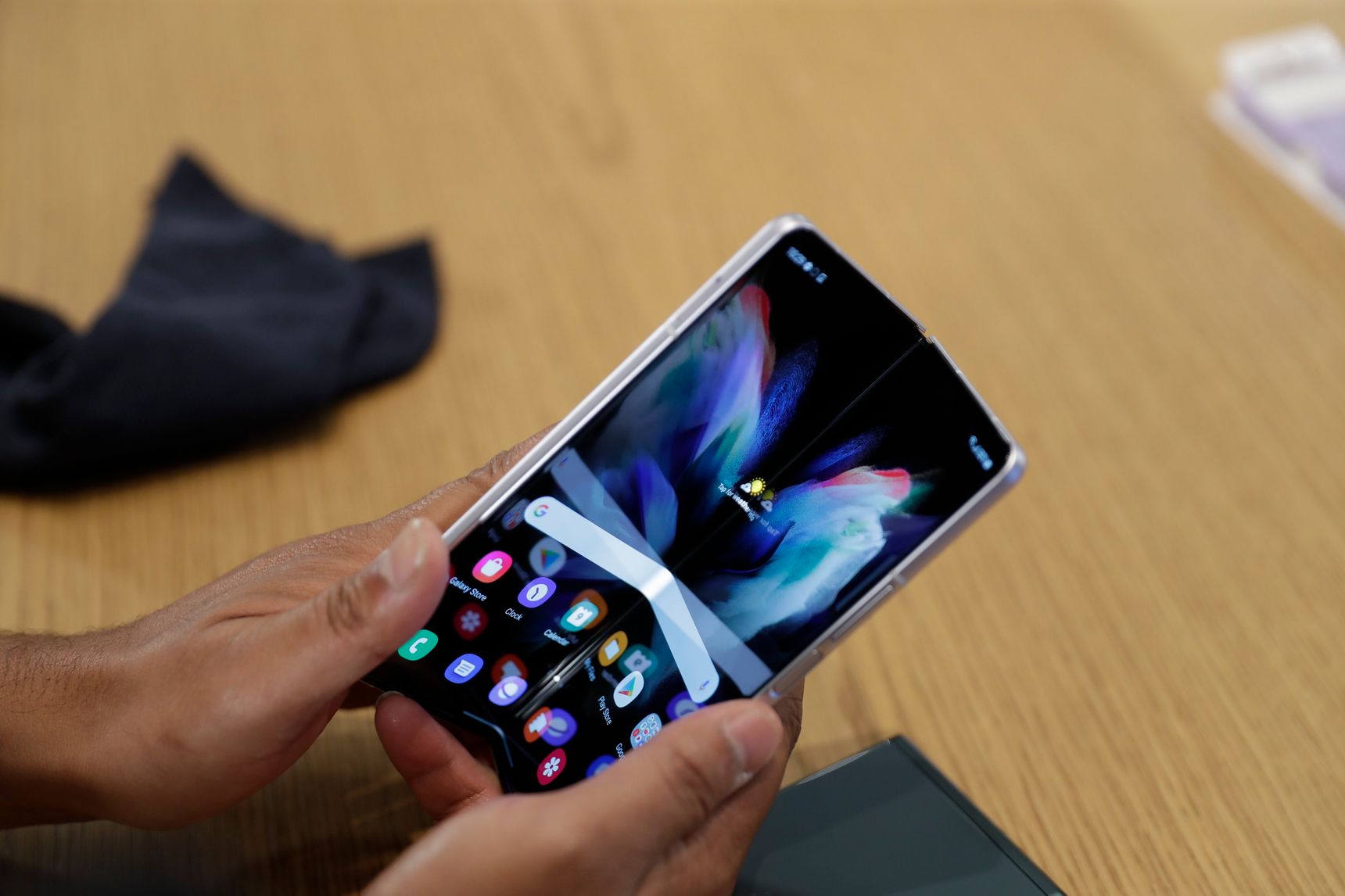Samsung Galaxy’s Foldable-Phone Pitch: Just Try Them
Company banks on more in-store visits and lower prices.
SEOUL—Samsung Electronics Co. is betting the world is finally ready for its foldable phones.
Consumers had initially balked at a price tag that hovered around $2500. Durability remained a concern. Closed stores during the pandemic meant few buyers could see and touch a foldable phone that looks dramatically different from everything else.
That has brought an underwhelming debut to what had been one of the smartphone industry’s most-hyped products of late. The device has a tablet-size screen that folds in half like a book, becoming small enough to carry in a hand, pocket or purse. When closed, a second display on the outside can field most tasks.
Roh Tae-moon, president of Samsung’s mobile-communications business, said he has heard all the complaints. He is hopeful the company’s two new foldable devices, which were unveiled Wednesday, become more than fringe products in the smartphone market.
“We’ve seen that users who have tried foldable phones like the experience and say they want to use them again,” Mr. Roh said. “But it’s hard to discover the value of foldables if they haven’t had a chance to experience them.”
Samsung’s earlier foldable phone models, first introduced in 2019, weren’t sales hits, industry analysts say. Mr. Roh doesn’t see them as flops: He said they established baseline expectations among consumers and set the ground for this year’s models.
One immediate shift in tactics: a lower price tag. The larger Galaxy Z Fold 3 5G will cost $2499 less than its predecessor. The more compact Galaxy Z Flip 3 5G is priced at $1499.
The foldable phones were among devices unveiled at Samsung’s Wednesday event, which also featured two new versions of its Galaxy Watch—developed in partnership with Alphabet Inc.’s Google—and its Galaxy Buds 2 wireless earphones.
Samsung, the world’s largest smartphone maker by shipments, dominates the foldable category. Just three other companies have rival foldable phones: Huawei Technologies Co., Xiaomi Corp. and Lenovo Group Ltd.’s Motorola.
Two million foldable phones were sold world-wide last year, or about one-quarter of initial projections before the pandemic, according to Strategy Analytics, a market researcher. Shipments of foldable phones this year are forecast to hit seven million units, it said.
That is a sliver of the 1.42 billion smartphones forecast to be shipped in 2021, according to Strategy Analytics. But foldable phones have outsize importance, both as a flashy product that might sway consumers to upgrade their devices and as a profit driver.
If Samsung could sell 10 million foldable phones a year, it would likely generate $1 billion in operating profit—a sum that would be greater than the combined operating profit last year of the global smartphone industry that uses Google’s Android operating system, said Neil Mawston, executive director at Strategy Analytics.
Though Apple Inc.’s iPhone has seen sales soar, the broader smartphone industry could use a breakthrough hit. Worldwide shipments have declined the past three years, according to Strategy Analytics. Global phone shipments will grow 9% this year, though will be roughly the same size as in 2019, according to the company’s forecasts.
Foldable phones were more disproportionately affected by the pandemic than standard ones, industry analysts say. Given their novelty and higher price, foldable phones are products that consumers would prefer to hold in their hands before making the leap, and that became difficult during lockdowns, said Sanjeev Rana, a Seoul-based senior analyst at brokerage CLSA.
“Nobody wants to spend $2,000 looking at a phone on the internet,” Mr. Rana said.
Samsung’s mobile business has a lot riding on the foldable phones becoming a success. The Suwon, South Korea-based company doesn’t plan to release a new version of its plus-size Galaxy Note device this year. Pandemic-induced production issues in Vietnam affected output in recent months, while Covid-19 outbreaks in markets such as India sapped demand. Samsung’s second-quarter mobile profit fell 26% from the previous quarter.
Mr. Roh, 52 years old, has led Samsung’s mobile unit since early last year, after spending decades working in the company’s mobile research-and-development team. Market intelligence shows that people are using their mobile devices more than before the pandemic, he said, and using them to do more types of tasks.
The South Korean company’s foray into foldable phones in 2019 began with controversy. Tech reviewers found structural flaws, including screens that bulged. Samsung delayed the original Galaxy Fold phone by months and fortified the design.
Making the foldable phones sturdier is a selling point for Samsung’s two new releases. A protective film for the main display will improve durability by 80% compared with the previous models, the company says. The devices have gotten thinner and lighter, and come bolstered with stronger frames and hinges. Both are waterproof. Neither has an earphone jack.
The pricier Galaxy Z Fold 3 has a main display that measures 7.6 inches diagonally, with an exterior cover screen of 6.2 inches. When opened, the front-facing cameras are embedded under the display, meaning the circular lenses largely disappear when using the phone. It is compatible with the S Pen stylus, a favorite for Galaxy Note fans, though it must be purchased separately. Apps have been further optimized to provide a better fit on folded screens, Mr. Roh said.
The more compact Galaxy Z Flip 3 has a 6.7-inch main display. The area of the exterior screen, which had previously been a thin bar, is now large enough to support four main apps and enables users to read several lines of notifications and messages without opening the device.
Preorders for Samsung’s newest foldable devices begin Wednesday in the U.S., with the phones hitting shelves Aug. 27 in several markets. Samsung is letting consumers in the U.S. trade in up to four devices, including those from other brands, for discounts that could reduce the price of the Galaxy Z Fold 3 to $1,000 or halve the price of the Galaxy Z Flip 3.
Jene Park, a senior analyst at Counterpoint Research, which tracks smartphone sales, said Samsung’s foldable-phone pricing this year should be more aligned with what consumers expect.
Lee Ji-hoon, a 37-year-old office worker in Seoul, is an early adopter. Last year, he picked up a Galaxy Z Fold 2 and can’t see himself ever going back to a conventional smartphone. He is hooked on the wider screen.
But Mr. Lee acknowledges one drawback, even when the device is closed. “The phone is too bulky to fit in my pants pocket,” he said.
 Copyright 2020, Dow Jones & Company, Inc. All Rights Reserved Worldwide. LEARN MORE
Copyright 2020, Dow Jones & Company, Inc. All Rights Reserved Worldwide. LEARN MORE
This stylish family home combines a classic palette and finishes with a flexible floorplan
Just 55 minutes from Sydney, make this your creative getaway located in the majestic Hawkesbury region.
As Paris makes its final preparations for the Olympic games, its residents are busy with their own—packing their suitcases, confirming their reservations, and getting out of town.
Worried about the hordes of crowds and overall chaos the Olympics could bring, Parisians are fleeing the city in droves and inundating resort cities around the country. Hotels and holiday rentals in some of France’s most popular vacation destinations—from the French Riviera in the south to the beaches of Normandy in the north—say they are expecting massive crowds this year in advance of the Olympics. The games will run from July 26-Aug. 1.
“It’s already a major holiday season for us, and beyond that, we have the Olympics,” says Stéphane Personeni, general manager of the Lily of the Valley hotel in Saint Tropez. “People began booking early this year.”
Personeni’s hotel typically has no issues filling its rooms each summer—by May of each year, the luxury hotel typically finds itself completely booked out for the months of July and August. But this year, the 53-room hotel began filling up for summer reservations in February.
“We told our regular guests that everything—hotels, apartments, villas—are going to be hard to find this summer,” Personeni says. His neighbours around Saint Tropez say they’re similarly booked up.
As of March, the online marketplace Gens de Confiance (“Trusted People”), saw a 50% increase in reservations from Parisians seeking vacation rentals outside the capital during the Olympics.
Already, August is a popular vacation time for the French. With a minimum of five weeks of vacation mandated by law, many decide to take the entire month off, renting out villas in beachside destinations for longer periods.
But beyond the typical August travel, the Olympics are having a real impact, says Bertille Marchal, a spokesperson for Gens de Confiance.
“We’ve seen nearly three times more reservations for the dates of the Olympics than the following two weeks,” Marchal says. “The increase is definitely linked to the Olympic Games.”

Getty Images
According to the site, the most sought-out vacation destinations are Morbihan and Loire-Atlantique, a seaside region in the northwest; le Var, a coastal area within the southeast of France along the Côte d’Azur; and the island of Corsica in the Mediterranean.
Meanwhile, the Olympics haven’t necessarily been a boon to foreign tourism in the country. Many tourists who might have otherwise come to France are avoiding it this year in favour of other European capitals. In Paris, demand for stays at high-end hotels has collapsed, with bookings down 50% in July compared to last year, according to UMIH Prestige, which represents hotels charging at least €800 ($865) a night for rooms.
Earlier this year, high-end restaurants and concierges said the Olympics might even be an opportunity to score a hard-get-seat at the city’s fine dining.
In the Occitanie region in southwest France, the overall number of reservations this summer hasn’t changed much from last year, says Vincent Gare, president of the regional tourism committee there.
“But looking further at the numbers, we do see an increase in the clientele coming from the Paris region,” Gare told Le Figaro, noting that the increase in reservations has fallen directly on the dates of the Olympic games.
Michel Barré, a retiree living in Paris’s Le Marais neighbourhood, is one of those opting for the beach rather than the opening ceremony. In January, he booked a stay in Normandy for two weeks.
“Even though it’s a major European capital, Paris is still a small city—it’s a massive effort to host all of these events,” Barré says. “The Olympics are going to be a mess.”
More than anything, he just wants some calm after an event-filled summer in Paris, which just before the Olympics experienced the drama of a snap election called by Macron.
“It’s been a hectic summer here,” he says.

AFP via Getty Images
Parisians—Barré included—feel that the city, by over-catering to its tourists, is driving out many residents.
Parts of the Seine—usually one of the most popular summertime hangout spots —have been closed off for weeks as the city installs bleachers and Olympics signage. In certain neighbourhoods, residents will need to scan a QR code with police to access their own apartments. And from the Olympics to Sept. 8, Paris is nearly doubling the price of transit tickets from €2.15 to €4 per ride.
The city’s clear willingness to capitalise on its tourists has motivated some residents to do the same. In March, the number of active Airbnb listings in Paris reached an all-time high as hosts rushed to list their apartments. Listings grew 40% from the same time last year, according to the company.
With their regular clients taking off, Parisian restaurants and merchants are complaining that business is down.
“Are there any Parisians left in Paris?” Alaine Fontaine, president of the restaurant industry association, told the radio station Franceinfo on Sunday. “For the last three weeks, there haven’t been any here.”
Still, for all the talk of those leaving, there are plenty who have decided to stick around.
Jay Swanson, an American expat and YouTuber, can’t imagine leaving during the Olympics—he secured his tickets to see ping pong and volleyball last year. He’s also less concerned about the crowds and road closures than others, having just put together a series of videos explaining how to navigate Paris during the games.
“It’s been 100 years since the Games came to Paris; when else will we get a chance to host the world like this?” Swanson says. “So many Parisians are leaving and tourism is down, so not only will it be quiet but the only people left will be here for a party.”
This stylish family home combines a classic palette and finishes with a flexible floorplan
Just 55 minutes from Sydney, make this your creative getaway located in the majestic Hawkesbury region.






















